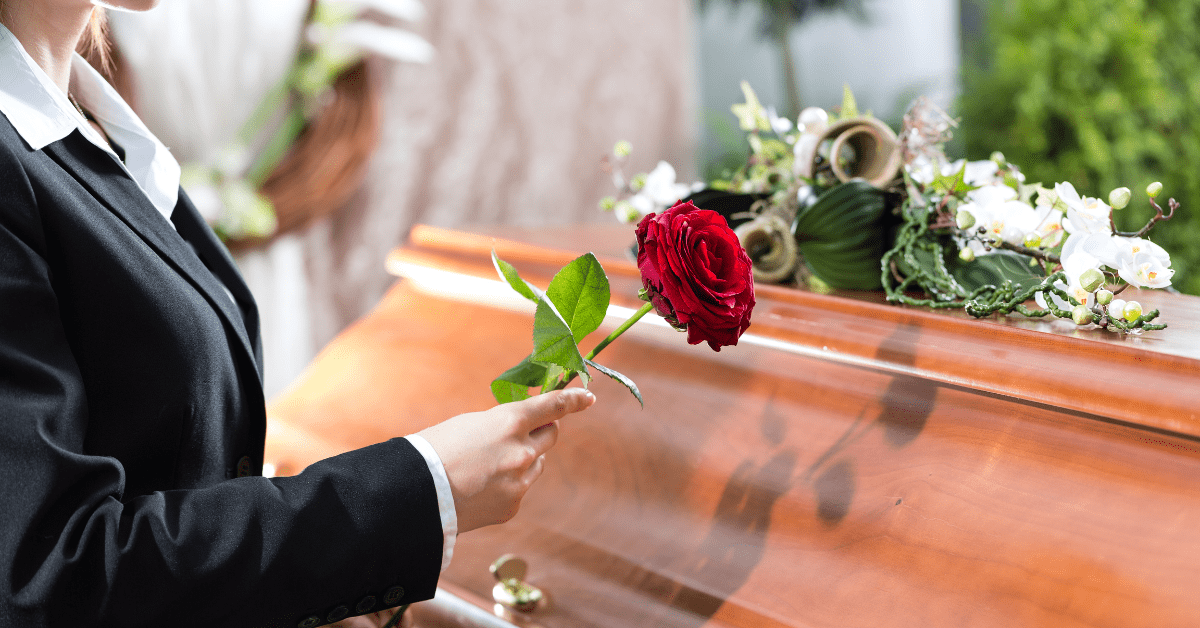Flowers can symbolise a final tribute, a way to turn a sombre occasion into something of beauty when arranged by a skilled florist. Today, you might find yourself wondering what becomes of these flowers after the funeral or cremation has ended. It’s a consideration, as these flowers carry the weight of farewells and unspoken words and for some could be difficult to discard.
Key Takeaways
- Funeral flowers can be repurposed into creative memorials like candles or scrapbooks.
- Donating flowers to charities or facilities extends their life and symbolism.
- Composting offers an eco-friendly disposal option, returning flowers to the earth.
- Repurposing or disposing of funeral flowers requires separating non-biodegradable materials.
The Significance of Funeral Flowers
Funeral flowers, symbolise love, sympathy, and respect, and play a critical role in the grieving process. When you’re arranging funeral flowers or choosing cremation flowers, you’re not just picking out decorations; you’re selecting symbols of honour that comfort the bereaved, under the guidance of a funeral director you should be able to find out what the floral arrangements are. Coffin flowers and funeral casket flowers serve as a final tribute to the departed, embodying the beauty of life and the sorrow of loss.
When sending flowers for a funeral, it’s essential to take into account the family’s preferences on the type of flowers and any cultural or religious significance. These gestures of condolence convey your support and empathy during a challenging time. The act of selecting and arranging funeral flowers can also be a therapeutic process, allowing you to express your feelings without words.
Understanding the Cremation Process
Cremation transforms the body of the deceased into bone fragments and ashes through intense heat, offering a space-saving and eco-friendly alternative to traditional burials. This process, usually completed within 2-3 hours, reduces the environmental footprint by conserving land and minimizing resource use. As you consider this option, it’s important to understand what happens during the cremation process and how it aligns with environmentally conscious choices.
After the cremation, the remains are processed into a powdery substance known as cremated remains or ashes. These are then placed in an urn, a container that can be kept by the family, scattered, or interred in a memorial site. Choosing an urn becomes a significant step in honouring the memory of your loved one in a respectful and personalized manner, guided by advice from a funeral director.
When it comes to funeral flowers, you might wonder how they fit into the cremation process. Though they don’t directly participate in the cremation, these flowers play a crucial role in the ceremony preceding it, adding a personal and meaningful touch to the farewell. Opting for eco-friendly funeral flowers can further complement your environmentally conscious choice of cremation, ensuring that your final tribute is as respectful to the planet as it is to the memory of the departed.
Cultural Practices and Beliefs
You’ll find that cultural practices and beliefs play a pivotal role when choosing funeral flowers after cremation.
For example, while Christians don’t have specific guidelines, Islamic traditions can vary widely, and Jewish customs typically avoid flowers altogether, favouring donations instead.
Hindu funerals often feature garlands, showcasing the diverse ways cultures honour their deceased.
Christians have no specific recommendations
In Christian practices, there are no strict guidelines on how to handle funeral flowers following a cremation, leaving it largely up to individual or familial preference. As a Christian, you’ll find that the disposition of funeral flowers after cremation can vary.
You might choose to keep certain flowers as keepsakes, symbolizing the memory of the loved one, turning flowers from the funeral home into lasting memorials. Additionally, it’s not uncommon for Christians to donate these flowers to hospices or charities, extending the gesture of love and remembrance to others in need.
Distributing funeral flowers among family members or integrating them into a garden are meaningful ways to honour the deceased. Ultimately, how you handle funeral flowers post-cremation is a personal choice, reflecting the unique wishes of the bereaved family.
Different parts of the Islamic faith have different beliefs
When considering sending funeral flowers to a Muslim family, it’s essential to recognize that beliefs and preferences can vary greatly within the Islamic faith. Islamic beliefs and funeral customs are diverse, and while some Muslims view flowers as acceptable sympathy gestures, others may find more meaning in practical help or charitable donations.
Understanding these cultural practices is key to offering support that resonates with the grieving family. As you navigate these decisions, keep in mind that the focus in Islamic funerals often leans towards honouring the deceased through prayers and support rather than floral tributes. Respecting these preferences is important, ensuring your gesture of condolence aligns with the family’s beliefs and contributes positively to their grieving process.
Jewish people do not usually display flowers at the service
Most Jewish funerals don’t include flower displays, focusing instead on charity donations and community support. According to Jewish customs, the emphasis is on quick burials and acts of kindness rather than ornamental flowers. This tradition stems from a desire to honour the deceased through meaningful actions, such as making charity donations in their memory.
During the Shiva period, which follows the burial, it’s common for friends and community members to support the bereaved family by bringing food, rather than flowers. This practice underlines the importance of community and practical assistance over symbolic gestures. The absence of flowers at Jewish funerals highlights a unique approach to mourning, one that prioritizes acts of kindness and tangible support over floral tributes.
Garlands are more commonly seen at Hindu funerals
Garlands, often made from marigolds, jasmine, and roses, are traditionally seen at Hindu funerals to honour the deceased. At these ceremonies, the vibrant hues and scents of fresh flowers play a significant role, deeply rooted in cultural customs.
Here’s what you need to know about garlands at Hindu funerals:
- 1. Symbolism: Garlands represent respect and honour for the departed soul.
- 2. Materials: They're crafted from fresh flowers, each with its significance.
- 3. Placement: These garlands may adorn the deceased during rites or be offered at the cremation site.
- 4. After Cremation: Respectfully disposed of, often in natural settings or designated areas.
Understanding these practices provides insight into the profound respect for life and death in Hindu traditions.
Popular Funeral Flower Choices
Selecting the right flowers for a cremation service can profoundly honour the memory of your loved one, with roses, lilies, chrysanthemums, carnations, and orchids being among the most meaningful choices. These funeral flowers, often chosen for cremations, carry deep symbolism such as love, beauty, loyalty, honour, and eternal life, making them perfect for expressing your condolences and support. Traditional tributes, including baskets, hearts, posies, wreaths, and sprays, commonly incorporate these flowers to convey respectful and sympathetic messages to the bereaved family.
When you’re unsure of the deceased’s favourite colour, opting for white flowers can be a safe and meaningful choice. White symbolizes purity, peace, and sympathy, fitting for expressing your sentiments during such a sensitive time. The choice of these flowers and their arrangements play an important role in funeral services, offering comfort to those grieving and serving as a beautiful tribute to the life and memory of the loved one. Remember, the flowers you select will carry your messages of love and remembrance, making them an essential aspect of the cremation service.
Repurposing Funeral Flowers
After exploring the significance of selecting meaningful funeral flowers for a cremation service, let’s examine how you can repurpose these floral tributes to keep the memory of your loved one alive. Instead of allowing these beautiful symbols to fade away, you can transform them into lasting mementoes. Here are four ways to give new life to funeral flowers after the funeral:
- 1. Floral Candles: Melt wax around the petals to create unique floral candles. This not only preserves the beauty of the flowers but also serves as a comforting light in remembrance of your loved one.
- 2. DIY Projects: Dry the petals for various DIY projects, transforming flowers after a funeral into cherished keepsakes. Whether it's crafting a piece of jewellery, a bookmark, or a decorative item, these projects allow you to hold onto the memories in a personal and creative way.
- 3. Sharing: Consider sharing the funeral flowers with friends and family after the funeral home service. This act of giving can help spread the warmth and memories associated with your loved one, fostering a sense of community and remembrance.
- 4. Memorial Scrapbook or Dried Flower Wreath: Press the flowers to include in a memorial scrapbook or create a dried flower wreath. Both serve as beautiful tributes that you can display in your home, keeping the memory of your loved one present and cherished.
Eco-Friendly Disposal Options
Exploring eco-friendly disposal options for funeral flowers guarantees a sustainable tribute to your loved one. After cremation, you’re often left with numerous floral tributes, including sympathy flowers and flowers after the funeral. Instead of letting them go to waste, consider sustainable handling methods that honour both the deceased and the environment. Composting is one eco-friendly option that transforms funeral flowers into nutrient-rich soil, contributing positively to the cycle of life. This method not only respects the natural decomposition process but also provides a meaningful way to give back to the Earth.
You might also think about distributing the flowers among family members or incorporating them into your garden. This approach allows the beauty and sentiments of the funeral flowers to continue in a new form, providing comfort and a lasting memory of the loved one. It’s essential to separate non-biodegradable parts before composting or repurposing, ensuring a truly sustainable practice.
Donating Flowers After Cremation
If you’re considering what to do with funeral flowers following a cremation, donating them to hospices, nursing homes, or charities can be a compassionate gesture that extends the spirit of remembrance and support. This act of kindness doesn’t just help you repurpose the floral tributes in a meaningful way; it also brings comfort and joy to others who may be going through a tough time.
When thinking about donating funeral flowers after cremation, here are a few points to keep in mind:
- 1. Check with Facilities: Make sure the hospices, nursing homes, or charities are open to accepting floral donations. Some might've specific guidelines or restrictions.
- 2. Transportation: Consider how you'll transport the flowers. You might need to arrange for delivery or ask volunteers to help.
- 3. Timing: Flowers are perishable. Plan to donate funeral flowers as soon as possible after the service to ensure they're still fresh and vibrant, adhering to the etiquette of managing flowers after a funeral.
- 4. Personal Touch: Adding a note explaining the donation can add a personal touch, making the gesture even more meaningful for the recipients.
Donating funeral flowers post-cremation isn’t only a sustainable choice but also a deeply meaningful one. It allows you to honour your loved one’s memory by spreading positivity and support to those who need it most.
Creating Lasting Memorials
Transforming funeral flowers into floral candles can create a unique and lasting memorial for your loved one. This process isn’t just about preserving the beauty of the flowers; it’s about keeping the memory of your loved one alive in a personal and meaningful way. You’re not limited to candles, though. Several DIY projects let you cherish these tokens of love and remembrance.
Drying the petals of funeral flowers opens up a world of possibilities. One of the most heartfelt projects you can undertake is creating a memorial scrapbook. It’s not just a book; it’s a collection of memories, where pressed flowers serve as poignant reminders of the life celebrated. Each page tells a story, making it a deeply personal keepsake.
Another beautiful way to honour your loved one is by crafting a dried flower wreath. This not only serves as a lasting memorial but also as a piece of art that embodies the love and memories shared. It’s a tangible connection to the person you’ve lost, offering comfort during times of sorrow.
Through these projects, funeral flowers transform from fleeting symbols of grief to lasting memorials, keeping the spirit of your loved one alive in your heart and home.
Cost Considerations for Flowers
When mulling over funeral flowers, it’s important to bear in mind that costs can vary widely, from affordable bouquets to more elaborate tributes that may stretch your budget. The average cost of funeral flowers in the UK can range greatly, making it essential to understand your options and find a balance between expressing your condolences and managing expenses.
Here are some key points to keep in mind:
- 1. Economical funeral flowers don't mean less sincerity; options exist for every budget.
- 2. The average cost of funeral flowers in the UK can start from as low as £20 and go up to £400, depending on the arrangement and size.
- 3. Sending flowers to a funeral should be guided by the family's wishes; some may prefer donations to a charity instead.
- 4. Do you take flowers to a funeral? Consulting with a funeral director can guide funeral flower etiquette.** Yes, but it's important to respect any specific requests or guidelines mentioned in the obituary or funeral announcement.
Personalizing Flower Arrangements
Selecting personal touches for flower arrangements during a cremation service can deeply honour the memory of the deceased. This includes choosing their favourite flowers or colours to create a meaningful tribute that reflects their unique personality and preferences. Going beyond traditional options like roses and lilies adds a layer of personal significance to the service.
When personalizing flower arrangements, consider incorporating special tributes that resonate with the deceased’s life story. This could be a heart-shaped wreath for someone known for their loving nature or a basket of wildflowers for an outdoor enthusiast. These choices help create a service as unique as the individual being celebrated.
Moreover, selecting flowers that were significant to the deceased not only personalizes the arrangement but also serves as a poignant reminder of their life and passions. A florist experienced in sympathy flowers can assist in this selection. By putting thought into these details, you ensure that the final farewell is a fitting and heartfelt homage to your loved one’s legacy.
Frequently Asked Questions
You’re wondering what to do with funeral flowers after a cremation? You can take them home, share them, or repurpose them into something new. It’s a thoughtful way to honour your loved one’s memory.
You’re probably wondering how long a crematorium keeps flowers. Typically, after a funeral, funeral flowers are often on display at the funeral home for a day or two before being sent home with the family or donated. After that, they’re removed. You’ve got the choice to take them home or leave them behind.
You might wonder what becomes of the flowers at a funeral. They’re often taken home by family or donated for a meaningful purpose. Some choose to preserve them as keepsakes or use them in creative projects.
You might wonder where funeral flowers go after the service. Typically, families take them home or distribute them as keepsakes. Some choose to place them in gardens as tributes, honouring their loved one’s memory.








